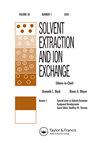Indium Extraction from Sulfate Solutions with a Mixture of Di(2-Ethylhexyl)Phosphoric Acid and Octyl Alcohol
IF 2.1
4区 化学
Q3 CHEMISTRY, MULTIDISCIPLINARY
引用次数: 0
Abstract
ABSTRACT In this work, solvent extraction of In(III) from sulfate solutions by using mixtures of D2EHPA with octyl alcohol and octanoic acid was investigated. The introduction of the additives into the organic phase was shown to lead to an antagonistic effect thus facilitating efficient indium stripping from the loaded organic phase. The antagonistic effect is significantly higher in the D2EHPA (HR) and octyl alcohol (HA) mixtures. The formation of stable associates between D2EHPA and HA leads to a decrease in the extraction efficiency of indium. In the presence of alcohol, almost complete stripping of indium from a D2EHPA loaded phase can be achieved to produce a strip liquor containing>33.0 g/L In. Based on the analysis of the extraction data and by using nuclear magnetic resonance (NMR) and infrared (IR) spectroscopy of the organic phases, it was concluded that indium extraction with D2EHPA in octyl alcohol is due to the formation of the extracted compound InR3. The equilibrium constant (logK) for indium extraction with solutions of D2EHPA in octyl alcohol was found to be − 0.12 ± 0.05. Extraction systems containing D2EHPA and octyl alcohol can be used to recover indium from various industrial solutions, in particular from the solutions derived from lead-zinc production and from liquid crystal display panel wastes.用二(2-乙基己基)磷酸和辛醇混合物从硫酸盐溶液中萃取铟
摘要本文研究了D2EHPA与辛醇、辛酸的混合溶剂萃取硫酸盐溶液中的In(III)。在有机相中引入添加剂会导致拮抗作用,从而促进从负载的有机相中有效地剥离铟。D2EHPA (HR)和辛醇(HA)混合物的拮抗作用明显更高。D2EHPA与HA之间形成稳定的缔合物,导致铟的萃取效率下降。在醇的存在下,从负载D2EHPA的相中几乎完全剥离铟,可以得到含>33.0 g/L In的条状液。通过对萃取数据的分析,结合有机相的核磁共振(NMR)和红外(IR)光谱分析,得出D2EHPA在辛醇中萃取铟是由于被萃取物InR3的形成。D2EHPA在辛醇溶液中萃取铟的平衡常数(logK)为- 0.12±0.05。含有D2EHPA和辛醇的提取系统可用于从各种工业溶液中回收铟,特别是从铅锌生产和液晶显示面板废料中提取的溶液中。
本文章由计算机程序翻译,如有差异,请以英文原文为准。
求助全文
约1分钟内获得全文
求助全文
来源期刊
CiteScore
4.40
自引率
5.00%
发文量
15
审稿时长
8.4 months
期刊介绍:
Solvent Extraction and Ion Exchange is an international journal that publishes original research papers, reviews, and notes that address all aspects of solvent extraction, ion exchange, and closely related methods involving, for example, liquid membranes, extraction chromatography, supercritical fluids, ionic liquids, microfluidics, and adsorption. We welcome submissions that look at: The underlying principles in solvent extraction and ion exchange; Solvent extraction and ion exchange process development; New materials or reagents, their syntheses and properties; Computational methods of molecular design and simulation; Advances in equipment, fluid dynamics, and engineering; Interfacial phenomena, kinetics, and coalescence; Spectroscopic and diffraction analysis of structure and dynamics; Host-guest chemistry, ion receptors, and molecular recognition.

 求助内容:
求助内容: 应助结果提醒方式:
应助结果提醒方式:


